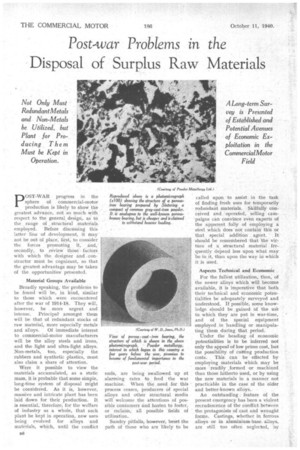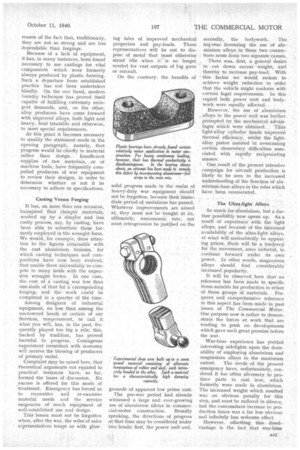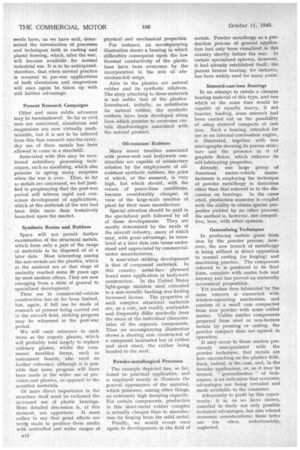Post-war Problems in the Disposal of Surplus Raw Materials
Page 24

Page 29

Page 30

If you've noticed an error in this article please click here to report it so we can fix it.
pOST-WAti. progress in the sphere of commercial-motor production is likely to show. the greatest advance, not so much with respect to the general, design,. as to the . range of ., structural .materials employed. Before discussing this latter line of development, it May not be out of place, first, to consider the fore' es promoting it, and, secondly, to review those' factors with which the designer and . constructor must be cognizant, so that the greatest advantage may be taken of the opportunities presented.
Material Groups Available
Broadly speaking, the problems to be found will be, in kind, similar to those which were encountered after the war of 1914-18. They will, however, be more urgent and intense. Principal .amongst them will be that of redundant stocks of raw material, more especially metals and alloys. Of immediate interest to commercial-motor manufacturers will be the alloy steels and irons, and the light and ultra-light alloys. Non-metals, too, especially the rubbers and synthetic plastics, must also claim a share of attention.
Were it possible to view the materials accumulated, as a static mass, it is probable that some simple, long-time system of disposal might be considered. As it is, however, massive and intricate plant has been laid down for their production. It is essential, therefore-, for the welfare of industry as a whole, that such plant be kept in .operation, new uses being evolved for alloys and materials, which, until the conflict ends, are being swallowed up at alarming rates to feed the war machine. When the need .f or this process ceases, producers of special alloys and other structural media will welcome the attentions of possible conSumers and hasten to foster, or reclaim, all possible 'fields of utilization.
Sundry pitfalls, however, beset the path of those who are likely to be
called upon to assist in the task of finding fresh uses for temporarily redundant materials. .Skilfully conceived and operated, selling campaigns can convince even experts of the apparent folly of employing a steel which does not contain this or that, special addition .. agent It should be remembered that the' virtues' of a , structural material fre,quently depend less upon what may be in it, than upon the way in which it is used.
Aspects Technical and Economic
For the fullest utilization, then of the newer alloys which will become available, it is imperative that both their technical and econOnaic potentialities be adequately surveyed and understood. If possible, some knowledge should be gained 'of the us-e to which they are put in war-time, and of the special equipment emplOyed in handling or manipulating them during that period. Under the heading of economic potentialities is to be inferred not only the appeal of low prime cost, but the possibility of cutting production costs. This can be effected by employing materials which may be more readily _formed or machined than those hitherto used, or by using the new materials in a manner not practicable in the case. of the older and better-known alloys. An outstanding. feature of the present emergency has been a violent recrudescence of the conflict between the. protagonists of cast and wrought forms. Castings, whether in ferrous alloys or in aluminium-base. allays,. are still too often neglected, by
reason of the fact that, traditionally, they are not so strong and are less dependable than forgings.
Because of a lack of equipment, it has, in many instances, been found necessary to use castings for . vital components which were formerly always produced by plastic forming. Such a departure from established practice 'has not been undertaken blindly. On the one hand, modern Foundry technique has proved itself capable of fulfilling extremely stringent demands, and, on the other, alloy producers have come forward with improved alloys, both light and heavy, heat treatable and otherwise, to meet special requirements.
At this point it becomes necessary to qualify the statement made in the opening paragraph, namely, that progress would be chiefly in material rather than design. Insufficient supplies of raw materials, or of machine tools, have frequently compelled producers of war equipment to review their designs, in order to determine whether or not it be necessary to adhere to specifications.
Casting Versus Forging
It has, on more than one occasion, transpired that Cheaper materials, worked up by a simpler and less costly process, say, by casting, have been able to substitute those formerly employed in the wrought form. We would,. for example, draw attention to the figuresobtainable with the cast aluminium bronzes, for which casting techniques and compositions have now been evolved, that enable them successfully to. compete in many fields with the expensive wrought forms. In one case, the cost of a casting was less than one-sixth of that for a corresponding forging, and the work could be completed in a quarter of the time.
Among designers of industrial 'equipment, no less than among the uncrowned heads of certain of our Services, temperament, or call it what you will, has, in the past, frequently played too big a role; this, backed by tradition, has proved harmful to progress. Courageous experiment consistent with economy will receive the blessing of producers of primary metal.
Complaint may be raised here, that theoretical arguments not equated to practical instances have, so far, formed the bases of discussion, No excuse is offered for this mode of treatment. Emergency has forced us to reconsider and re-examine material needs and the service exigencies of much equipment of well-established use and design.
This lesson must not be forgotten when, after the war, the wiles of sales representatives tempt us with glow
ing tales of improved mechanical properties and pay-loads. Those representatives will be out to dispose of metal that must otherwise stand idle when it is no longer needed for vast outputs of big guns or aircraft.
On the contrary, the benefits of
solid progress made in the realm of heavy-duty war equipment .Should not be forgotten, because their iliumdiate period of .usefulness has passed. Whatever improvements are aimed at, they must not be bought at an, ultimately, uneconomic rate, nor must retrogression be justified on the
grounds of apparent low prime cost.
The pre-war period had already witnessed a large and ever-growing use of aluminium alloys in commercial-motor construction. Broadly speaking, the directions of progress at that time may be considered under two heads; first, the power unit and, secondly, the bodywork. The Mir etus favouring the use of aluminium alloys in these two connections arose from two separate causes.
There was, first, a general desire to cut down excess weight, and thereby to increase pay-load. With this factor we would reckon to achieve weight reduction in order that the vehicle might conform with certain legal requirements. In this regard both power unit and bodywork were equally affected.
However, the use of aluminium alloys in the power unit was further prompted by the mechanical advantages which were obtained. Thus light-alloy cylinder heads improved thermal efficiency, whilst the lightalloy piston assisted in overcoming certain elementary difficulties associated with rapidly reciprocating masses.
' 'One result of the present intensive campaign for aircraft production is likely to. be seen in the increased understanding of the function of aluminium-base alloys in the roles which have been enumerated.
The Ultra-light Alloys So much for aluminium, but a further possibility now opens up. M result of experience with the light alloys, and because of the intredsed availability of the ultra-light alloys, at what will undoubtedly be appealing prices,. there will be a tendency for the movement, once initiated, to continue forward under its own power. In other words, magnesium alloys should find considerably increased popularity.
It will be observed . here that no reference has been made to specific items suitable for production in either of these groups of materials. Frequent and comprehensive reference to this aspect has been made in past issues of The Commercial Motor. Our purpose now is rather to demonstrate the forces at work that are tending to push on developments which gave such great promise before the war.
War-time experience has yielded interesting sidelights upon the desirability of employing aluminium and magnesium alloys to the maximum extent. The needs of the present emergency have, unfortunately, rendered it too often .necessary to produce parts in cast iron, which formerly were made in aluminium. The increased weight which resulted wa3 an, obvious penalty for this step, and must be suffered in silence, . but the concomitant increase in production times was a far less obvious and infinitely•less welcome effect.
However, offsetting this vantage is the fact that war-time needs have, as we have said, determined the introduction of processes and techniques both in casting and plastic forming, which, after the war, will become available for normal industrial use. It is to be anticipated. therefore, that when normal practice is reverted to pre-war applications of both aluminium and magnesium will once again be taken up with still further advantage.
Present Research Campaigns Other and more subtle advances may be foreshadowed. So far as civil uses are concerned, aluminium and magnesium are now virtually unobtainable, but it is not to be inferred from this that research into the everyday use of these metals has been allowed to come to a standstill.
Associated with this may be mentioned subsidiary processing techniques, such as anodizing, which also promise to spring many surprises when the war is over. Thus, so far as metals are concerned, we feel justified in prophesying that the post-war period will witness rapid and conscious development of applications, which at the outbreak of the war had been little more than tentatively launched upon the market.
Synthetic Resins and Rubbers Space will not permit further examination of the structural metals, which form only a part of the range of materials to be disposed of at a later date. Most interesting among the non-metals are the plastics, which at the moment are at that stage of maturity reached some 20 years ago by most modern alloys. They are now emerging from a state of general to specialized development.
Their use in commercial-vehicle construction has so far been limited, but, again, if full use be made of research at present being carried out in the aircraft field, striking progress may be witnessed in the post-war period.
We will omit reference to such items as the organic glasses, which will probably tend largely to replace ordinary glases, whilst the commoner moulded forms, such as instrument boards, also need no further reference, although it is possible that some progress will have been made in the wider use of precision-cast plastics, as opposed to the mOulded materials.
Of more direct importance in the structure itself must be reckoned the increased use of plastic bearings. More detailed discussion is, at this moment, not opportune. It must suffice to say that great efforts are beirrg made to produce these media with controlled and wider ranges of
physical and mechanical properties.
For instance, an accompanying illustration shows a bearing in which difficulties consequent upon the low thermal conductivity of the plastic base have been overcome by the incorporation in the mix of aluminium-foil strips.
Akin to the plastics are natural rubber and its synthetic relatives. The story attaching to these materials is not unlike that of the plastics. Introduced, initially, as substitutes for natural rubber, the synthetic rubbers have been developed along lines which promise to overcome certain disadvantages associated with the natural product.
Oil-resistant Rubbers Many minor troubles associated with power-unit and bodywork construction are capable of satisfactory solution by the employment of oilresistant synthetic rubbers, the price of which, at the moment, is very high, but which should, with the return of peace-time conditions, become considerably cheaper, in view of the large-scale erection of plant for their mass manufacture.
Special attention should be paid to the specialized path followed by all of these developments. They are mostly determined by the needs of the aircraft industry, many of which may, with great advantage, be translated at a later date into terms understood and appreciated by commercialmotor manufacturers.
A somewhat striking development is that of compound materials. In this country metal-face plywood found some application in bodywork construction. In the United States light-gauge stainless steel cemented to a non-metallic backing was finding increased favour. The properties of such complex structural materials are, as a rule, not readily analysable and frequently differ markedly from the mean of the individual characteristics of the separate components. Thus an accompanying illustration shows a steering arm constructed of a compound laminated bar of rubber and steel sheet, the rubber being bonded to the steel.
Powder-metallurgical Processes The example depicted has, so far, found no practical application, and is employed merely to illustrate the general appearance of the material, which possesses, among other things, an extremely high damping capacity. For certain components, production in this sheet-metal rubber complex is actually cheaper than to manufacture by forging from the solid metal.
Finally, we would revert once again to developments in the field of metals. Powder metallurgy as a production process of general application had only been visualized in this country shortly before the war. In certain specialized spheres, however, it had already established itself ; the porous bronze bearing, for instance, has been widely used for many years.
Sintered-cast-iron Bearings In an attempt to obtain a cheaper bearing material of this type, and one which at the same time would be capable of equally heavy, if not heavier, loading, some research had been carried out on the possibility of using sintered compacts of cast iron. Such a bearing, intended for use in an internal-combustion engine, is illustrated, together with two micrographs showing its porous structure and the presence in it of graphite flakes, which enhance its self-lubricating properties. .
Already, one large group of American motor-vehicle manufacturers is employing the technique of powder metallurgy in directions other than that referred to in the discussion on bearings. In the cases
• cited, pioduction economy is coupled with the ability to obtain special properties yielded by no other process; the method is, however, not competitive, here, with other systems.
Generalizing Techniques In producing certain gears from iron by the powder process, however, the new branch of metallurgy is being utilized in direct opposition to normal casting (or forging) and machining practice. The component referred to is produced in its final form, complete with centre hole and keyway and has proved an eminently economical proposition.
Yet another item fabricated by the same concern is connected with window-operating mechanism, and consists of a small cam compacted from iron powder with some added matter. Unlike similar components prepared from steel or non-ferrous metals by pressing or casting, the powder compact does not squeak in operation.
It may occur to those readers previously unacquainted with the powder technique, that metals are here encroaching on the plastics field. Such, indeed, is the case, and, in the broader application, or, as it may be termed, " generalization " of techniques, is an indication that economic advantages are being revealed and made available to the consumer.
Adequately to profit by this opportunity, it is, as we have shown, essential to study not only possible technical advantages, but also related economic considerations; these latter are too often, unfortunately, neglected.




















































